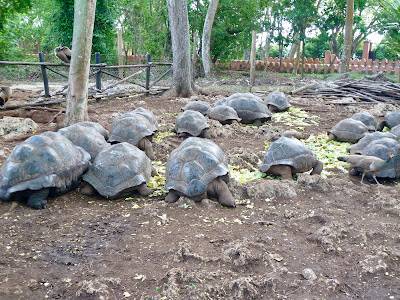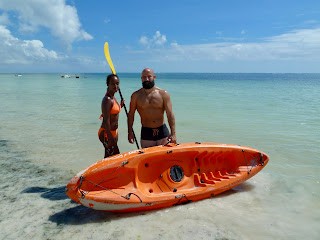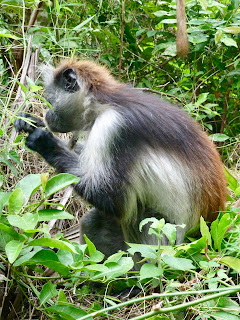7th - 9th Nov 2020
 |
The ex-Sultans' Palace. Now museum.
|
Back to Stone Town and Bottoms Up hotel. At least I know where I am when I get there. As mentioned previously it is a surprisingly decent place with a very helpful owner (Dr, recently qualified, Dishan) and his able assistant (Ali) and a parrot called Kasuku which makes loud whistling noises.

Right: Breakfast on the roof of Bottoms Up. A decent view. The bird sitting on the railing is an Indian crow. These are unwelcome pests in the country. They make a foul noise, have vicious beaks, eat other birds' eggs and, when tables are vacated, swoop in to scavenge left-over food. I am tempted to leave a nasty surprise for them.
Right: The rather 'mature' lady serving the breakfast has to climb up 5 flights of steep wooden stairs to deliver it. She has a great sense of humour and very cheerful. She deserves a medal, or at least a tip!

The ex-Palace museum was now open for visitors. Left: The Grand, rather threadbare, Staircase. It was built in the mid-19th century by Sultan Said, or Sayeed (arab spellings variable in English). Complicated arrangements between Germany and Britain left the island as a British protectorate with the Sultans notionally in charge. The Palace was destroyed by a British bombardment in the Anglo-Zanzibar war in 1896 because the 'wrong' Sultan (Ali) acceded (shortest war in history at between 38-45 mins). Then rebuilt and inhabited by other Sultans until, following independence from Britain, the 'Zanzibar Revolution' of 1964. This horrific African rebellion ended the Sultans' reign and the final Sultan, Jamshid bin Abdullah, did a swift runner on his 'Royal Yacht'. Many Arabs were brutally murdered.
Right: The Sultan's audience chamber. Much of this museum was in a rather moth-eaten and dusty state. However, they have done their best.
As you can imagine there were lots of 'guides' desperately persistent to offer their services but I managed to avoid them.

Left: Princess Salme's bedroom. An interesting lady. Died in 1924. She married a German. Good story if you can be bothered.

Right : A typical Sultan. Seyidd Said (I think) 1790-1856. The first Sultan in Zanzibar.

Left: The Sultan's bedroom. There are lots more dusty rooms I took photos of, but the above should give you the gist.
Right: The original portable wash-stand, water tank on top, was wheeled into the bedrooms of Sultan & Co if they were too lazy, or incapacitated, to get up.
Left: Nearly finally, you may be relieved to hear, the Sultan's Panasonic TV outside in a passageway. Or, more likely, that of the present day security guard.

Right: One of the last Sultan's cars. Forgot to note what make it is but I'm sure some eager researcher will tell me. I think it is British.
(Ford Zephyr, I have been advised).

Left: The car used by the last British Resident (Commissioner) before the Revolution in 1964. Austin Princess?

Now for some real 'culture': The Freddie Mercury Museum on Kenyatta Road (The Oxford Street of Stone Town). The legendary 'chanteur' Freddie Mercury, aka Farrokh Bulsara, is the second most famous Zanzibarian. The most famous being the fabulously wealthy 19th century ivory trader, Tippu Tip (I'm presently reading a book about him by some British Academic. It is fabulously complicated and almost unreadable). Actually this book does give an insight into the lives and the most extraordinary exploits of African explorers and entrepreneurs of the 19th century (Livingstone, Stanley and many others), but I digress.........
The museum entry cost $10 (reduced to $8); vastly expensive by Zanzibar standards. It consists of one largish room around the walls of which are numerous photos of, and letters written by, F. Mercury.
I was the only visitor at the time.
In the centre is an internal room containing a silent video of 'Queen' (his band) playing at Wembley stadium, a large photo and a grand piano with a sparkly yellow leather jacket on top (presumably one of his stage outfits). 'Queen' music was playing in the background.
Freddie (Farrokh) was born in Zanzibar to Persian parents in 1946. They emigrated to India where he was educated and returned to Zanzibar after schooling. The family fled to England in 1964 because of the revolution.
Left: Young Freddie (in India) was a keen sportsman.

He became the flamboyant lead singer of the rock band 'Queen', was a notorious shirt-lifter and died of AIDS in 1991.
To be honest, the museum was no great shakes. I was somewhat disappointed. Not a patch on the ABBA museum in Stockholm (see previous Sweeden blog).

Left: A colourfully dressed lady in Stone Town. Many of the women wearing Muslim outfits made the point of having colourful ones...other than the few wearing those black bin-liner/letter-box outfits.

Right: A typical Muslim mans's outfit. They too often had colourful hats and dish-dashes.

Left: The Post Office on Kenyatta Road. An efficient establishment with helpful staff. I posted some cards which took a week to arrive in UK. Good going, especially compared to some I posted in Colombia a year or two ago which took 6 months to arrive.
Right: Opposite the Post Office is the (relatively) rather upmarket shop 'Memories'. As well as souvenirs it sells clothes, books and other stuff. It is also well air-conditioned which adds to its attraction.
Left:..........and a rather less upmarket establishment around the corner. I dread to think what they had been selling....
Right: The bandstand and café on Forodhani Gardens, on the sea-front opposite the fort. A pier juts out into the sea and there is a ceremonial arch at the water's edge; built to welcome Princess Margaret on a state visit in 1956.
Left: A gaily decorated street in the town. They must be celebrating something. I think it might be the Indian Diwali knees-up. A hotel I visited was preparing for a major do in this respect.
Right: The Laughing Policeman. Sgt Elias of the Zanzibar Police. He was often to be seen in the town centre, very smart and always smiling. He usually carried a 'swagger stick' under his left arm...replaced here by a radio. A delightful character.
More to follow from the Stone Town area.



































































